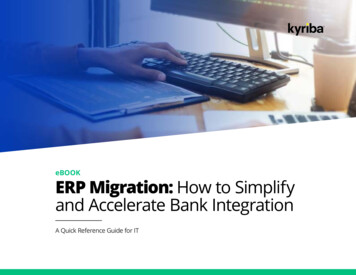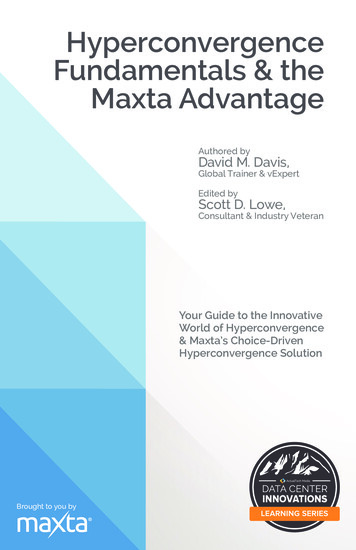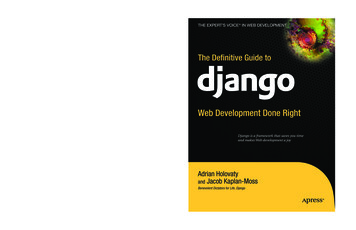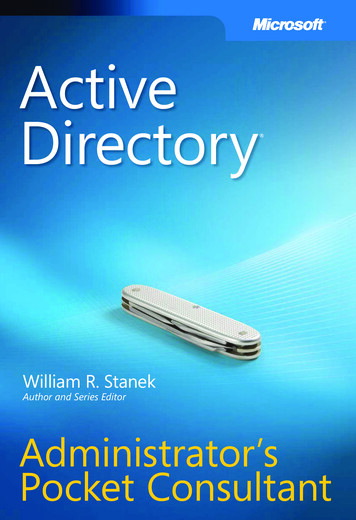
Transcription
eBOOKERP Migration: How to Simplifyand Accelerate Bank IntegrationA Quick Reference Guide for IT
ContentsIntroduction. . . . . . . . . . . . . . . . . . . . . . . . . . . . . . . . . . . . . . . . . . . . . . . . . . . . . . . . . . . . . . . . . . . . . . . . . . . . . . . . . . . . . . . . . . . . . . . . . . . . . . . . . 3Bank Integration: What’s Involved? 4What are the Challenges? 5Complexities for IT 6SWIFT Certifications and Expertise 7Why Kyriba? 8Conclusion 10
E-BookIntroductionSimplify and accelerateA major shift is underway in the world of enterpriseresource planning (ERP) software. With both customers andERP vendors driving a mass migration to the cloud, manycompanies have already completed their ERP cloud migrationprojects—and thousands more are set to follow suit by the endof this decade.The good news is that companies can considerably simplify andaccelerate the bank integration component of ERP migration.By taking advantage of a SaaS-based multi-tenant, connectivityfocused technology solution, companies can access pre-builtconnectivity and bank transformation capabilities—therebyshaving months off the migration project, and ultimatelyreducing payment connectivity and format costs by up to80 percent.But ERP cloud migration is a costly and time-consumingundertaking, particularly where IT is concerned. For companiesseeking to digitize their enterprise applications, it’s clear thatcorporate IT will be heavily taxed for the foreseeable future.Meanwhile, ERP firms and system integrators are poised toreap the benefits of years of migration project work.IN THIS EBOOKYou will learn about the key areas to look at duringan ERP cloud migration payments project, including:The challenges of bank integrationFor corporations, ERP migration projects are often global innature—and many will need to tackle the complexity of a globalbanking integration project.Following banks’ schedulesNavigating geographical variationsSWIFT certificationThis element of ERP migration is particularly challenging,significant coordination is needed with the company’s banks,and there is a considerable disparity between the paymentformats required by different banks across different geographicregions. Indeed, bank integration is often cited as one of theriskiest and most challenging elements of ERP cloud migration.Resourcing challengesYou’ll also find out how you can significantly reducethe cost and time required to complete your ERPmigration project.Copyright 2020 Kyriba Corp. All rights reserved.-3-Kyriba and the “kyriba” logo are trademarks of Kyriba Corp.
E-BookBank Integration:What’s Involved?Bank integration is unlike any other system integration. Today’s corporate ITteams are experienced in building interfaces between different back-officesystems—but these are typically stagnated interfaces that do not requireadditional resources.In contrast, when working on a bank interface, the IT team will typically needmany different resources to coordinate with each other, including IT, treasury,accounts payable (AP), the connectivity team, SWIFT Service Bureau and thebank’s tech team. What’s more, the project timeline is usually at the mercy ofthe bank’s schedule.Testing and re-testingOnce the specifications have been developed, they rarely pass their firsttest. As a result, the development team will need to rebuild, re-test and workthrough the coordination effort all over again. In some cases, two to five roundsof testing may be needed before the test format is approved by the bank.Once the bank has approved the specifications, IT will then need to workthrough its internal procedures—namely development, testing, QA, nonproduction and production. In practice, it can often take six months or more todevelop, test and release a single payment format into production to be utilizedby the business owner.Copyright 2020 Kyriba Corp. All rights reserved.-4-Kyriba and the “kyriba” logo are trademarks of Kyriba Corp.
E-BookWhat are the Challenges?For IT, the bank integration component of an ERP cloudmigration brings a number of additional challenges.Many organizations have yet to implement effective safeguardsin order to identify and defend against payment fraud.According to research by Strategic Treasurer in 2019, onlynine percent of organizations have implemented paymentsmonitoring/screening, while only three percent are takingadvantage of AI/machine learning.As well as financial loss, payment fraud can also damage acompany’s reputation and lead to the loss of essential data.It’s therefore essential to put measures in place to protect theorganization from these risks. This should include digitizingpayment workflows, standardizing controls and screeningpayments.Working on the banks’ timelinesDelays in the ERP migration project often arise due to delays bythe company’s banks. If the company has a robust relationshipwith a core banking partner, it may be able to move upthe project queue for that particular bank. But with manycorporations needing to manage dozens of banks globally, theIT team will be forced to follow those banks’ schedules—whichmeans working across different time zones and navigatingbanking holidays and seasonal moratoriums on testing.Navigating geographical variationsNo two banks are the same, and it’s a common misconceptionthat SWIFT is a standard message type across banks. WhileSWIFT is moving from MT to XML, each bank will still haveits own unique requirement in terms of how it will acceptincoming files.For any payment type, companies will need to ensure thatpayments are formatted correctly for a specific bank’srequirements and that they contain the information the bankneeds to complete the payment. Most corporations will needmultiple formats per bank, which might include differentformats for low value, high value and FX transactions.Given the complexities, it’s no surprise that IT firms routinelytake two years or more to work through all these bankconnections and payment format testing.Limited IT bandwidthLast, but certainly not least, corporate IT teams are alreadythinly spread across numerous projects and supportrequirements. As such, the time involved in undertaking a bankintegration project can be particularly onerous.Copyright 2020 Kyriba Corp. All rights reserved.-5-Kyriba and the “kyriba” logo are trademarks of Kyriba Corp.
E-BookComplexities for ITResource requirementsAdding to these challenges, bank integration brings anumber of complexities where IT is concerned.Once formats are in production, the IT infrastructure team willneed to manage those formats going forward. This involvesactivities such as troubleshooting bank issues, editing formatsas required by the bank and working with the business to addnew banks when the need arises. Depending on the company’sbanking footprint, two to five people will likely need to betasked with managing these connections on an ongoing basis.No reusable dataWhen IT teams work on an ERP deployment, they have todevelop their banking interfaces as a one-off exercise. WhileERPs may be moving to the cloud, ERP solutions are stilltypically private cloud providers—and no ERP in the market hasreadily available, reusable banking formats that can be sharedamong users.Multiple stagingsBank and payment format development is no different than forany other interface or application, as IT has to work throughthe same rigorous processes. If the business users need a newpayment format, such as a new ACH for an existing bank, theywill still need to go through the process of testing, QA, nonproduction and production. This process can take months,meaning there will be a considerable delay before the end userhas access to the payment format.Copyright 2020 Kyriba Corp. All rights reserved.-6-Kyriba and the “kyriba” logo are trademarks of Kyriba Corp.
E-BookSWIFT Certificationsand ExpertiseOne new issue facing companies that run SWIFT are the new requirementsmandated for 2020. Following the 81 million Bangladesh Bank heist in 2016,SWIFT took steps to increase security not only around its infrastructure, but forthe mandates required by companies controlling their own BICs.Many companies looking to manage their own SWIFT connection opt for AllianceLite2 (AL2), a cloud-based solution that enables manual or automated messageexchange with counterparties. But under the new requirements for 2020, theinternal IT support team will need to go through annual certification and testingin order to keep their validation for SWIFT.For internal IT teams, this imposes considerable risks—and indeed costs. Forone thing, IT teams will now need to have internal SWIFT domain expertiseand will require annual recertifications. If the company has only one or twocertified resources, questions will need to be asked about what happens if thisresource leaves the company, who can act as back-up if the resource is off sickor otherwise unavailable, and what the cost and time implications will be when anew resource needs to be trained.Copyright 2020 Kyriba Corp. All rights reserved.-7-Kyriba and the “kyriba” logo are trademarks of Kyriba Corp.
E-BookWhy Kyriba?ERP bank integration brings many challenges for IT—but these can be overcome by adopting a connectivity-focused technologysolution that simplifies bank connectivity, mitigates risks and accelerates the project.With 20 years’ experience in bank connectivity, Kyriba can help.Accelerate your ERP project and reduce costs. Ourout-of-the-box, bolt-on bank connectivity can help youreduce the time spent on bank integration by as much as 80percent, as well as save hundreds of thousands of dollars.Focus on the wider project. Kyriba’s connectivity platformfrees IT up from the daunting task of bank integration—soyou can focus on keeping the ERP project on schedule andon budget.Access a payment format library. As a multi-tenantapplication, Kyriba is unique in the marketplace as ourentire 2,500-strong customer base uses the same predeveloped and tested payment formats. What’s more,we have full-time staff whose sole responsibility is tobuild and test payment formats. As a result of 20 years ofdevelopment, we offer more than 45,000 pre-developed andbank-tested unique payment scenarios.Avoid the need for SWIFT connectivity andcertifications. When you use Kyriba for connectivity, ITwon’t need to manage the Alliance Lite2 SWIFT connection—and there will be no need for annual testing andcertifications.Simplify interfaces. Minimal IT resources are needed whenit comes to interfacing between the ERP system and Kyriba.Using both SFTP and API, we take all payment files into ourprebuilt interfaces with no code specs needed from IT.Manage ongoing maintenance and support. When theproject is over, Kyriba will handle all ongoing maintenanceand will act as the banking IT support arm for businessusers, meaning you won’t need dedicated IT resources totroubleshoot bank issues.Copyright 2020 Kyriba Corp. All rights reserved.-8-Kyriba and the “kyriba” logo are trademarks of Kyriba Corp.
Why Kyriba cont.E-BookConnectivity as a Service. By offering Connectivityas a Service (CaaS), Kyriba can actively manage bankconnections on your behalf. As a result, no IT support willbe needed to manage your company’s bank connectionsor undertake file testing with banks—and companies canalso add new banks in a fraction of the time that would beneeded for custom development within the ERP.Innovation and agility hub. Payment technology isevolving rapidly—and Kyriba’s innovation and agility hubmeans we can adapt to new payment solutions such asreal-time payments (RTP), same-day ACH, Zelle, Venmo andPayPal. New solutions can be deployed quickly in our SaaSmulti-tenant architecture, avoiding the need for a timeconsuming custom deployment within the ERP.Market-leading payment fraud protection. With ITincreasingly tasked with risk mitigation, Kyriba’s marketleading payment fraud solution adds considerable value.The solution uses machine learning to detect any anomaliesor suspicious activity, and provides alerts to stop paymentsfor investigation before they are sent to the bank.Smart assignment. Kyriba’s machine learning will havevisibility to your banking partners and costs associated witheach payment. Smart assignment can intelligently routeyour payments through the lowest cost provider.Payment tracking. Kyriba offers real-time paymenttracking with four levels of acknowledgement. Byharnessing SWIFT gpi, Kyriba is able to track the entirelifecycle of the transaction.Copyright 2020 Kyriba Corp. All rights reserved.-9-Kyriba and the “kyriba” logo are trademarks of Kyriba Corp.
E-BookConclusionERP cloud migration is a major undertaking—and for many corporations, the bank integrationexercise can be among the most daunting aspects of the project.From working around banks’ schedules and specifications, to achieving SWIFT certification and expertise, there are manychallenges for IT to navigate—and that’s in addition to all the existing demands faced by time-strapped IT teams. But when itcomes to deploying an ERP project, many teams will want to keep their resources engaged on the overall strategic project.Fortunately, by providing bolt-on bank connectivity, prebuilt interfaces and an extensive format library, Kyriba can considerablyaccelerate and simplify your ERP migration project. Payment and connectivity costs can be reduced by hundreds of thousandsof dollars, while the time spent on bank integration can be streamlined by as much as 80%. What’s more, freeing up the IT teamfrom having to work within the constraints of the banks will help you keep the wider ERP project on time and on budget.Learn MoreCopyright 2020 Kyriba Corp. All rights reserved.- 10 -Kyriba and the “kyriba” logo are trademarks of Kyriba Corp.
SELEC T BR ANDS USING K YRIBAABOUT KYRIBAKyriba empowers CFOs and their teams to transform how they activate liquidity as a dynamic, real-time vehicle for growthand value creation, while also protecting against financial risk. Kyriba’s pioneering Active Liquidity Network connects internalapplications for treasury, risk, payments and working capital, with vital external sources such as banks, ERPs, trading platforms, andmarket data providers. Based on a secure, highly scalable SaaS platform that leverages artificial and business intelligence, Kyribaenables thousands of companies worldwide to maximize growth opportunities, protect against loss from fraud and financial risk,and reduce costs through advanced automation. Kyriba is headquartered in San Diego, with offices in New York, Paris, London,Frankfurt, Tokyo, Dubai, Singapore, Shanghai and other major locations. For more information, visit www.kyriba.com.Copyright 2020 Kyriba Corp. All rights reserved. Kyriba and the “kyriba” logo are trademarks of Kyriba Corp.
Meanwhile, ERP firms and system integrators are poised to reap the benefits of years of migration project work. The challenges of bank integration For corporations, ERP migration projects are often global in nature—and many will need to tackle the complexity











